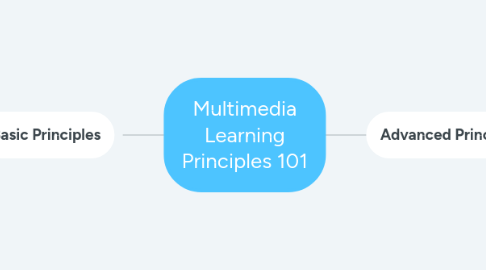
1. Basic Principles
1.1. Maintaining generative processing
1.1.1. Multimedia Principle
1.1.1.1. Pictures included with words, rather than words alone
1.2. Managing essential processing
1.2.1. Segmenting Principle
1.2.1.1. Information is presented in chunks or segments
1.2.2. Pre-Training Principle
1.2.2.1. Keep the focus on the names and characteristics of main ideas
1.2.3. Modality Principle
1.2.3.1. Information is presented using graphics and narration
1.3. Social Cue Principles
1.3.1. Personilization Principle
1.3.1.1. Conversational style presentations
1.3.2. Voice Principle
1.3.2.1. Human voice narrations
1.3.3. Image Principle
1.3.3.1. No speaker graphic needed (focus is on voice)
1.3.4. Embodiment Principle
1.3.4.1. Including drawings during explanations
1.4. Reducing extraneous processing
1.4.1. Coherence Principle
1.4.1.1. Excluding extra information
1.4.2. Signaling Principle
1.4.2.1. Highlighting main information
1.4.3. Redundancy Principle
1.4.3.1. Only including graphics and narration
1.4.3.1.1. One of two on-screen keywords can be beneficial
1.4.4. Contiguity Principle
1.4.4.1. Words and pictures are together
2. Advanced Principles
2.1. Animation Principle
2.1.1. Adding clear and defined movements to graphics
2.2. Collaboration Principle
2.2.1. 1. Tasks should be demanding
2.2.2. 2. Should stimulate thoughts while members carry out processes
2.2.3. 3. Facilitate effective communication
2.3. Expertise Reversal Principle
2.3.1. Design principles that are effective for novice learners, may not be effect for advanced learners
2.4. Learner Control Principle
2.4.1. Learners should have control over the pace, sequence, and information aids of a lesson
2.5. Feedback Principle
2.5.1. Feedback given should be explanatory rather than corrective
2.5.1.1. Why it needs to be corrected VS. What needs to be corrected
2.6. Worked Examples Principles
2.6.1. Learners should have the opportunity to learn from real life examples
